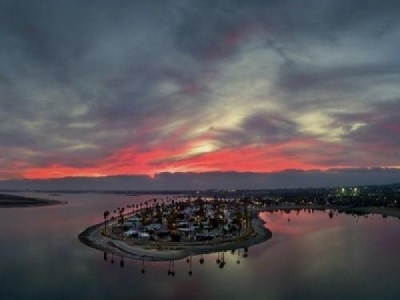
Posted on December 11, 2018
The last remaining patch of wetland in Mission Bay, just east of Crown Point, fosters meandering tidal creeks, colorful vegetation, flocks of squabbling birds, and abundant tiny creatures. Nearby lies an area of Mission Bay Park that has, for the last 50 years, been leased to the De Anza Cove mobile home community. This space also had been coastal wetland in the past. Now, its future is being decided as the city of San Diego has undertaken a planning process for “De Anza Cove Revitalization.”
The plans put forth by the city include nods to the value of wetlands but prioritize an expanded golf course, among other sports facilities. Though Mission Bay Park plans have endorsed the concepts of restoration and stewardship for decades, they have neglected to set adequate goals. Likewise, the city’s current study on the site and its prospects for revitalization only takes projected rising sea level into account in a very limited sense. It stipulates that long-term structures be built above the 5.5 feet of sea-level rise that it projects for this century, but — without planning sufficient intertidal and upland restoration area into which wetland plants can shift over time — tacitly accepts the total drowning of wetlands in Mission Bay.
Related: Why Mission Bay Gateway is right plan for De Anza revitalization
Wetlands and other “living shorelines” can reduce coastal flooding impacts for a fraction of the cost of man-made solutions such as sea walls. A recent study estimates that, if we keep to business as usual, the global cost of sea-level rise will exceed $10 trillion per year by 2100, while sustainable coastal management can lower this cost to about $1 trillion per year. Closer to home, the interstate, the trolley line currently under construction and the low-lying buildings neighboring De Anza Cove — not to mention any recreational activities in the park — owe their future security to coastal planning that adapts to sea level rise.
The science-based proposal for De Anza revitalization put forth by San Diego Audubon, ReWild Mission Bay, was dismissed early in the city’s planning process. Proponents of ReWild have attended public meetings in droves, but their calls for action have been held in check or simply drowned out by demands from other interest groups.
And herein lies what’s most troubling about this whole affair: The environment is not a special interest group, and yet it is constantly treated like one.
There seems to be a fundamental disconnect between the way we talk about sustaining our environment and protecting against climate-change impacts and the way we develop public space and spend taxpayer dollars. Our city and state leaders voice their intent to address environmental crises, but the steps necessary to meet these aspirations are often not implemented on the ground. The process of revitalizing De Anza Cove has served as a prime example of our struggle to meet our own goals, to prepare for the future and to treat the Earth kindly.
Wetlands once spanned nearly all of Mission Bay. Today, they exist as a much smaller fragment of native habitat. These wetlands and the creatures they support are as Californian as the development interests that seek to replace them. In addition to bolstering coastal areas against rising seas, these marshes trap carbon in the ground, fighting climate change at its source. They also serve as important nurseries for economically valuable species (such as Pacific Halibut) and improve the bay’s water quality. Restoring more of Mission Bay’s wetlands and investing in these areas, not only for conservation but education and recreation, will allow more opportunities for us all to benefit from them.
Thursday (Dec. 6), San Diego Audubon’s ReWild plan for the De Anza Cove area will be released at a public workshop at Mission Bay High School. This winter, the city Parks and Recreation Department will present its draft Project Environmental Impact Review for De Anza, at which point it will undergo public comment and committee review.
San Diego’s identity and future as a coastal haven are borne from its unique and valuable ecosystems. So what can we do to prevent coastal wetlands from becoming nothing more than a part of our city’s history? Engage! Comment! And call on your city leaders to make the most of our San Diego coast, now and for the future.
Source: The San Diego Union-Tribune





